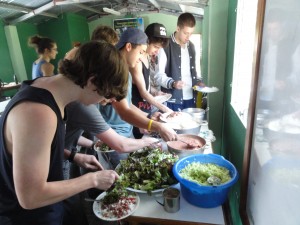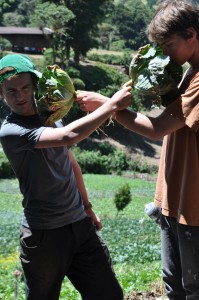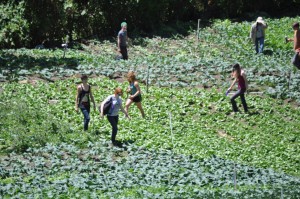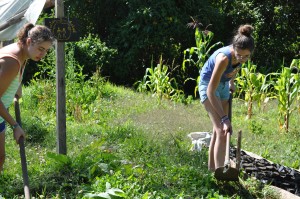The group (Atenas track) that just arrived from Costa Rica continues to settle into the cloud forest and went on their first excursions through forest trails. Their evening ended with a lively discussion spurred by Abel, our fabulous guide and friend from Los Quetzales, about how the cloud forest, agriculture, politics and life in this region has transformed over the past 30 years.
Meanwhile, today marked our group’s (Pedasí track) gradual descent from one of the highest elevations Panama has to offer. We awoke with our bags packed to make the trek out of the cloud forest by foot and then by tractor-pull. Meeting up with two locally-based NGO groups here in Guadalupe, AMIPILA (Amigos del Parque Internacional la Amistad) and FUNDICCEP (Fundacion para el desarrollo integral comunitario y conservacion de los ecosistemas de Panama), which are led by siblings Ana and Luis Sanchez, we learned about their organizations and then headed to the demonstration farm fields where they got us working in two groups.
Through their leadership, we tilled the Earth, weeded, cleaned the fields, packed dirt into bags for seedlings, and harvested some tasty vegetables. When we returned to the AMIPILA office base, we all took turns helping them to prepare a very healthy lunch of freshly picked lettuce and cabbage, as well as frijoles, tomates de arbol, and plantains all grown nearby or at a family member’s farm. Our lunch helped us all appreciate where our food came from and gave us an opportunity to reflect on the rich soils that we have encountered up here near Cerra Punta.
Upon finishing our lunch, Luis and Ana spoke to us at greater length in Spanish about the importance of the new farming techniques that their organization has embraced to help the soil on the steep hillsides of this region last longer. They explained their struggle to convince other local farmers to change farming practices from the least sustainable vertical rows and high use of chemical inputs to an approach that helps the land endure for years to come by adding rich organic compost and following the contours of the land across the sloping terrain.
With some new vocabulary to keep them interested, the students listened attentively and engaged with interesting questions about farming practices. Shortly thereafter, the students were picked up by their homestay families, to spend one evening and morning fully immersed with farming families, who have strong ties to the AMIPILA organization. We will be checking in with the students Wednesday morning to see them working side-by-side with their families and we cant wait to catch up and see how their first homestay has been.




